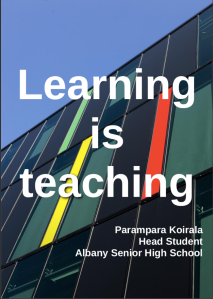I have always thought I could be a lifelong learner and as I complete my last blog of this course I fully believe I am lifelong learner and I just love learning new things ! This is nicely summed up by one of my tutor students who is also a head student and a saying which has been captured from one of her speeches and is displayed around school.

What has made the learning even more worthwhile is the ongoing opportunities to collaborate, discuss and be presented with research and evidence to promote critical reflection and develop myself as a reflective practitioner as someone who can
“develop a greater level of self-awareness about the nature and impact of their performance, an awareness that creates opportunities for professional growth and development.” ( Osterman & Kottkamp 1993)
Using the New Zealand teachers professional body that has the expectations for professional standard, The Ministry of Education, Practicing Teacher criteria for e-learn the 2 criteria I have chosen are:-
Criteria 4 – Demonstrate commitment to ongoing professional learning and development of professional personal practice.
Working in an already established and new modern learning environment school the reflective aspect of this course has provided an opportunity to evaluate the strengths and the possible areas which could be further developed to make it a environment for 21st century learners in an open community. I have always said to people who ask “what’s it like in open spaces?” the space really is irrelevant, it could be a cow shed! Its the teaching and learning experience which matters and I am very grateful for the Mindlab course to make me really sit back and critique my own practice to ensure I am continually keeping in mind the aim of developing 21st century life long learners. The key experiences which have had an impact on my practice are; one, the agile methodologies and project based learning moving to interdisciplinary learning opportunities. Two, how being connected for both student and teacher is vital in preparing for beyond the classroom and developing and enhancing skills such as collaboration, innovation and creativity. I have tried, tested and reflected on the use of SCRUM, gamifying challenges, real world based problem solving and using different collaboration activities. Some with success and will definitely be continuing with next year, some which need time spent on them to make into worthwhile authentic learning experiences and some which still need a wee bit of more testing!
Criteria 7 – Promote a collaborative, inclusive and support learning environment
Building relationships that matter has been a goal this year. The Mindlab assignment on professional inquiry (PI) I really enjoyed doing for two reasons. I final understood really what a good PI should look like even though I have supposedly been doing it for the past 2 years at my school. I sure know what I do now to make it rigorous and meaningful for my students. Although the assignment was a planning activity, I actually carried out most of mine and collected student voice to influence my teaching inquiry, planned interventions and collected evidence to feedback to my students to support and intern benefit all my students not just those of the focus group.Secondly this opportunity and others has also provided opportunity for conversations that matter with my colleagues and particularly my deputy principal. I have had many conversations around my learning and reflections, growing my relationship with her, much to her surprise at times about the extent of my personal professional growth she was previously unaware of.
Next professional development dream – real big this one!
To bring those teachers who teach with agile methodologies & agile classrooms, Eduscrum and quest based learning Q2L to New Zealand to learn and collaborate with, which could lead to working with liked minded teachers here to make this work for senior students studying NCEA. ( or maybe I need a trip the countries in which they practice!)
Final THANKS
I can’t sign off without a heartfelt thanks to the wonderful facilitators, my fellow students particular those who have made up the Saturday crew for for the fun, support, laughter, conversations and collaboration. Good luck for whatever is your next big dream.
References
Osterman, K. & Kottkamp, R.(1993). Reflective Practice for Educators.California.Cornwin Press, Inc. Retrieved from http://www.itslifejimbutnotasweknowit.org.uk/files.
Ministry of Education (nd). Practising teacher Criteria and e-learning . Retrieved from http://elearning.tki.org.nz/Professional-learning/







